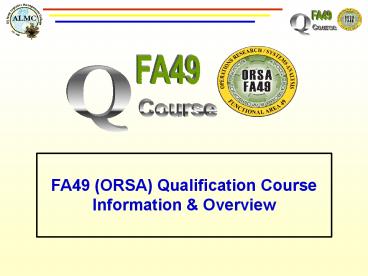FA49 ORSA Qualification Course Information - PowerPoint PPT Presentation
1 / 11
Title:
FA49 ORSA Qualification Course Information
Description:
'Military History is written by those analysts whose study recommendations were approved' ... of Three (3) Graduate Credit Hours in Management Science. ... – PowerPoint PPT presentation
Number of Views:2828
Avg rating:3.0/5.0
Title: FA49 ORSA Qualification Course Information
1
FA49 (ORSA) Qualification Course Information
Overview
2
Briefing Agenda
- FA49 Q-Course - Why?
- Concept
- Learning Approach
- Course Summary Curriculum
- Course Composition Student Assessment
- Other FA49 Q-Course Information
3
Why an FA 49 Qualification Course?
In the Year of our Lord 2009, patriots of
Scotland - starving and outnumbered - charged the
fields of Bannockburn. They fought like
warrior poets they fought like Scotsmen, and won
forever, their freedom.
Military History is written by those analysts
whose study recommendations were approved
4
Why an FA 49 Qualification Course?(For Real)
Q-Course Goals
Mandates
Prepares Officers
For supervisory positions on senior staff
5
FA 49 Q-Course Concept
6
FA 49 Q-Course - Focus on Required Skills
leading to Proposed Critical Tasks
- Formulate solutions to complex problems.
- Formulate Problem Develop Constraints,
Limitations Assumptions (Scope) - Decompose
Problem Develop Metrics Plan Analysis. - Apply technical analytic skills to military
issues. - Proper selection application of tools,
techniques and analytic processes Scenarios
Models Data Research Issue Expertise. - Conduct analysis.
- Execute Integrate Sensitivity Trade-Offs
Findings Insights Conclusions. - Communicate complex ideas in terms relevant to
the audience. - Communicate relevant credible analysis for
leadership to make valued decisions Speak to
operational concerns via critical thinking
decision-maker perspective.
DA PAM 600-3, Commissioned Officer Professional
Development and Career Management, Chapter 34,
Operations Research/Systems Analysis Functional
Area 49
7
FA 49 Q-Course - Learning
Approach
Design Experiential Learning Model
Adult Learning Model Andragogy - Learner is
Self Directing, Resource for Learning, Applies
Life Experiences Performance Centered
- Method Socratic -
- Promote Critical Thinking
- Give Questions, Not Answers
- Leading Statements
- Reasoning
- Self Assessment
8
FA 49 Q-Course Curriculum
Course Module
Academic Hrs
Curriculum Content
Types Impact of Army studies, Problem
Formulation, MS, Analysis Planning, Scenario
Development, Analysis Integration
Communication, Analysis Leadership (Includes
ROPES)
51
Studies
PAE, Test and Evaluation, Force Development,
AMSAA, HR, Sister Services, Joint Analysis, Cost
Affordability, Support to Combat Operations,
CAA, TRAC, JCIDS
60
The Role of Analysis
World Trends, Current Threat, Operational
Environment, Threat Development and Study Support
Process
4
Operational Environment
Joint Operational Concepts, ACP, CSA Focus Areas,
Modularity, Transformation, and Future Forces
7
Transformation
Additional 12 hrs of Homework
End-to-end Exercise which integrates course
content into a current analysis case study.
Introduced first week of course. Culminates in
briefings to Senior ORSA leadership in Mock SAG
102
Capstone Exercise
9
Class/Student Composition
- Class is typically 15-18 students - organized
into 3 Student Analysis Teams (SAT) - Primarily Army Majors in CFD 49
- Includes AGR officers
- FA49 Proponency (Army G8) extends invitations to
- - Sister Services (Navy, AF, USMC Military
Civilian Analysts) - - DA Civilians in GS 1515 (ORSA) Career Series
(GS12/13) - - Selected Allied Officers in Operational
Analysis Assignments
10
Student Assessment
- SAT presentations during practical exercises
- Capstone Exercise and Capstone Component
Leadership Role (Course Director and Peer
Assessment) - Brown Bag briefing
- Individual Problem Formulation Scripted Briefing
(Self Assessment) - Individual participation in PEs and general
lesson discussions
Successful completion of FA49 Q-Course results in
designation of CSC Qualified in conjunction
with ILE Professional Military Education
requirements.
11
Other Information
- January 2007 Completion of FA49 Q-Course now
results in accreditation of Three (3) Graduate
Credit Hours in Management Science. (ACE
American Council on Education)

